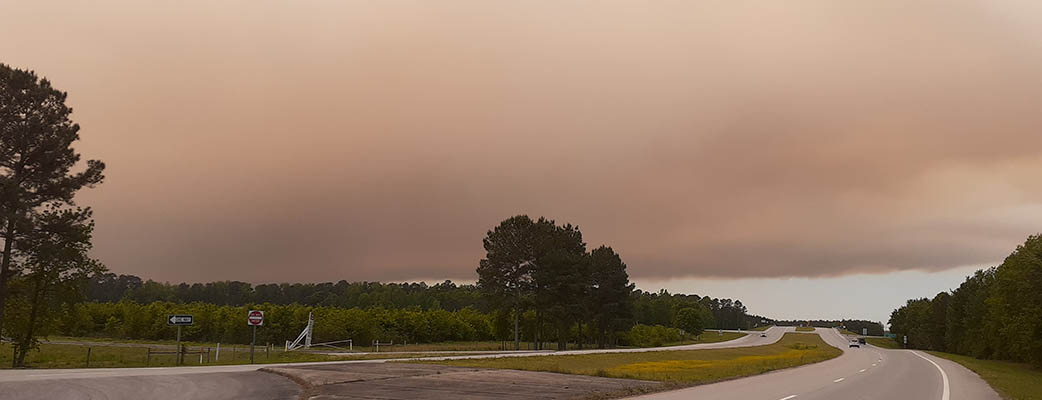
The Great Lakes Wildfire in the Croatan National Forest led federal and state forestry officials to call for renewed measures to prevent and contain future blazes.
Members of the U.S. Forest Service Community Mitigation Assistance Team that responded to the fire appeared before the Craven County Board of Commissioners on May 15. The CMAT members are currently working to help communities adjacent to the forest better prepare for future wildfires.
Jonathan Bruno, CMAT lead, explained that the interagency team had been invited by the Croatan National Forest and N.C. Forest Service to help develop a partnership focused on local wildfire mitigation.
“The reason being is that there will be another fire. The Croatan is an ecosystem that sees fire every 14 years roughly,” Bruno said, pointing to previous major fires in 1994 and 2012.
Bruno said the CMAT team held a strategic planning meeting at the Riverfront Convention Center in New Bern and met with Craven County emergency management and fire department personnel.
“Our focus is to really help to learn lessons from this fire and to be prepared for the next one,” Bruno said.
Watch video here:
As of March 15, the Great Lakes wildfire, which began on April 4, was 90% contained and burned 32,400 acres, according to information from the U.S. Forest Service.
David Nelson, district fire management officer with the Croatan Forest, explained that roughly half of the 160,000 acre Croatan Forest is made up of upland Pocosin, a word derived from Native Americans that means “swamp on a hill.” Nelson said the roughly 80,000 acres are filled with vegetation such as wax myrtle and gallberry that is highly flammable.
“It’s a high concentration of very volatile fuels that are seasonably available starting in the spring and summer…When it burns you can have flame lengths of over 100 feet, so 120-foot length flames coming towards you,” Nelson said.
In its early stages the Great Lakes wildfire moved quickly towards the communities surrounding the Croatan like Riverdale and other areas between Cherry Point, Havelock and James City, he explained.
“It ran from the southwest where Craven, Carteret and Jones (counties) all meet and in one day and one night it moved 11 miles towards these communities,” Nelson said.
According to Nelson, a shift in the wind the following day turned the fire towards areas south of the Trent River in New Bern, Brices Creek, Perrytown and into Jones County.
He said the neighborhoods of Bluewater Rise, Taberna and Carolina Colours were also impacted.
Nelson noted that there remains a “high fire potential” in the middle of the Croatan Forest. He said the main focus of the CMAT team is annual funding for hazardous fuel reduction through prescribed burning. Early each year wildlife officials burn the understory between the high hazard pocosin swamps and the communities to create buffer zones, he explained.
“Between last year and this year, we burned roughly 8,000 acres,” Nelson said. “The Great Lakes fire hit the burn we did last year and the burn we did in March and stopped the forward progression toward the Highway 70 corridor.”
Nelson said developments like Bluewater Rise are encroaching closer and closer to the hazardous pocosin areas. Regular prescribed burning of underbrush, he noted, is one solution to prevent wildfires from spreading rapidly to inhabited areas.
“Longleaf is a pine where we safely, with low-intensity fire, do understory burns so the forest is still intact and it’s a healthy ecosystem where the 100-foot flames hit that and drop down to less than 5-foot flames and then we’re able to catch that,” he explained.
Hannah Thompson, wildfire mitigation specialist with the N.C. Forest Service, said a “greater partnership” is necessary between state and federal wildlife agencies and local fire departments.
She asked for the Craven Board of Commissioners support in creating the Croatan Fireshed Partnership and in updating the local Community Wildfire Protection Plan and the Emergency Operations Plan.
Thompson said effective prevention must also include fire adaptive communities that are prepared before the next fire occurs.
“Your leadership is necessary as we look to empower residents to prepare for all hazards,” Thompson said. “And we believe a community that is ready for wildfires is also going to be ready for the next hurricane and the next storm.”
Thompson said the CMAT would hold wildfire mitigation training with key partners in the area through May 18.
On May 17, CMAT planned to present its findings and recommendation at Craven Community College during a closeout meeting from 10 a.m.-12 p.m.
By Todd Wetherington, co-editor. Send an email with questions or comments.

